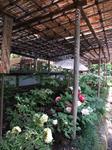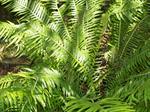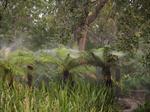
Shaded plants have some especial needs but are not hard to cater for
In many ways, plants in shaded areas are more susceptible to certain problems that those growing in more open conditions. With reduced light, there is often less vigorous growth and in turn, less resistance to pest and disease troubles. With slower evaporation and less air movement, the shaded area can be wetter with resultant fungal problems. Shady areas can even have the opposite problem; being too dry, because the tree canopy or pergola which creates the shade, also stops the rain from reaching the ground.
Shaded areas need to be watched a little more closely than sunny parts of the garden. Watch out for any changing conditions in the health of plants, movement of air, slipperiness of surfaces, intensity of shade or the degree of drainage.
WATER
Less evaporation occurs in shaded areas due to less sunlight and reduced air circulation. Shaded areas often have wetter conditions than adjacent open areas and this often results in fungal problems. This is particularly true when the shading is caused by features such as rock walls, pergolas or buildings, rather than trees. When shade is caused by large trees, the tree roots may keep the area very dry and the tree foliage may prevent moisture from reaching the soil. Rain may run off the foliage and not onto the ground or evaporate from the foliage before reaching the ground.
Plants with large systems of surface roots may make it difficult for other plants to get both nutrients and moisture, making it difficult to establish new plants in the shade.
Water the soil, not the foliage of plants in the shade. The roots need to be kept moist for the plant to survive, but wet leaves are more susceptible to fungal diseases and wet leaves remain wet a lot longer in the shade. The exception to this is for plants such as ferns, which may actually prefer moist foliage.
Irrigation may be needed in areas if rainfall is inadequate, if adjacent vegetation utilises existing water to a large degree, or if there are physical barriers such as overhanging building parts. Simple irrigation systems are readily available and easy to set up.
The amount of water that your garden requires will depend on many factors:
Type of Plant
Some plant varieties utilize more water than others while others have a greater resistance to dry conditions – cacti and succulents are extreme examples. There are many hardy species that require a minimum of watering. However, even most native gardens will need additional moisture if rainfall is scarce during summer.
Rate of Growth
If a plant grows rapidly, perhaps because of its variety, or due to ideal growing conditions, it uses water at a faster rate.
The Weather Conditions
This varies enormously, but some areas experience much higher rainfall and gardens therefore need less watering. When the weather is hot, soil loses water through evaporation. In windy conditions, both the soil and leaves of the plant loses water at a fast rate. In humid areas or seasons, less water may be needed.
 The Type of Shade
The Type of ShadeUnder eaves and alongside buildings is often a very difficult area that doesn’t even become moist after rain. There is often so much competition for moisture under trees and shrubs that the ground will become dry even shortly after watering.
When to Water
In shaded areas, watering times are not a critical as for exposes hot places. Avoid late afternoon watering in winter though if your climate is cold, as this can encourage fungal diseases. Always remember to water deeply to encourage plant roots to grow down. A slow flow of water for a long period will wet the soil more deeply and thus last longer.
The Soil Type
Sandy soils dry out fast and therefore need more watering. Heavy clay soils hold the moisture longer but don’t necessarily allow it to reach plant roots effectively. Both soil types will improve if organic matter such as compost is added to help their texture and water holding capacity. The use of products like that may assist in retaining soil moisture.
Length of Watering
In sandy soils you can apply a lot of water quickly and it will be absorbed. In heavy clay soils you must water slowly over a long period – heavy applications will not soak in and a lot will be lost as run off. Deep rooted plants such as trees should be watered slowly over a long period, so as to wet the soil to a greater depth. Such plants can also be watered less often.
Shallow rooted plants such as annual flowers and vegetables need frequent watering. Plants in the shade will require less frequent watering than those in full sun.
 Ways to Water
Ways to WaterAutomatic systems are the easiest way to supply water to your plants. There are many different devices available which can automatically switch the flow of water off, or both on and off.
The simplest device is a manually operated clock which allows water to flow for the period of time it is adjusted to and then switches off. This lets you switch your watering system on and then forget about it.
The most complex systems are computer controlled and allow you to set the time of day and duration of watering. This type of controller will turn on and off several different lines of sprinklers, whether you are at home or not. Though complex in the number of tasks they can perform, these controllers are easy to operate and for the average home handyman, relatively easy to install. There are drawbacks though. If set to water then forgotten, you can find them watering already wet gardens during the rain.
Fixed systems such as drip irrigation with manual control are often better, because you can vary the amount of water applied to the soil to match the climatic conditions.
Trickle or drip irrigation is probably the best sort of irrigation for use in shaded areas, as it directs water to where it is needed. A properly designed trickle system will ensure correct application rates in the right place with minimum wastage of water and no interference with the people who use the garden – sprinklers can spray people, trickle outlets do not.
Trickle irrigation systems apply water at low pressure through a system of polyethylene microtube outlets. Although the design of systems varies greatly, the basic components of all trickle systems include a pressure regulator to ensure water pressure is even between droppers, a filter, control valves and drippers.
Trickle pipes and tubes, being low density plastics, are flexible and easy to hide among rocks and plants. Laterals can be buried and outlets placed in very obscure positions if so desired. It laterals are not buried, the gardener has even greater flexibility in being able to move the position of the outlet if desired to wet and dry areas. Unlike sprinkler irrigation, trickle has no problem with distribution of water being interfered with by growing shrubs and trees.
Trickle irrigation is popular with home gardeners for a number of reasons:
- Water is directed exactly where the plant needs it most – the plant roots. Loss of water from wind and excess run off is minimised, giving a saving on water rates and conserving increasingly scarce water supplies.
- Although trickle systems are initially time consuming to set up and occasionally require some on-going maintenance, they are permanent fixtures which are often fully automated. Busy-work schedules and holidays are no longer a problem with such a system.
- People, paths, furniture and clothe lines close to the water outlet aren’t wet when the system is on.
- Weeds have less chance of germinating because not as much of the soil is moist.
- Trickle systems don’t wet the foliage and flowers. Wet foliage and flowers are more susceptible to diseases.
DO-IT YOURSELF MICRO IRRIGATION SYSTEMS
These consist of 3 main types of components:
- Black plastic pipe. When soaked in very hot water, this becomes pliable and can be simply pushed over connectors to join it to other sections of pipe or attachments.
- Connectors. Three-way and four-way joints used to connect sections of pipe together.
- Outlets. Moulded plastic outlets which discharge the water either as a spray or a drip. A hole is simply poked in the pipe wherever you want to discharge water and a nozzle (sprinkler) or dripper (trickle outlet) is pushed or screwed into the hole. Believe it or not, it will hold in that position and not leak when the water is turned on.
The advantages of this type of irrigation are numerous, but all the advantages can be nullified by clogging of the delivery points. This in turn can lead to isolated dry spots and in the extreme, death of the affected plants. To help counteract this problem, the following measures should be considered: installation of a reliable filter in the main line; regular inspection of all watering points to check for blockages; flushing of the system with plain water to prevent blockage by impurities.
Micro-jet Irrigation
Where trickle irrigation provides a slow dripping of water at one point, micro-jet irrigation provides a small jet or spray of irrigation from on point.
Both methods use water more effectively than conventional sprinkler irrigation, particularly when delivering water to garden beds, crops or individual trees.
Trickle irrigation has many advantages over spray irrigation but in some situation, problems can arise with it; most of which are avoided with micro-jet irrigation.
Problems with trickle irrigation may occur in sandy soil, where the water moves straight down and there is little horizontal movement in the soil. In some soils, salt can build up (shown by a white caking) in the area where the water is applied. There is also some research to indicate that root development is restricted, particularly with larger plants, to the wetted area.
Micro-jet irrigation can greatly reduce all of these problems.
The size and spacing of micro-jets is critical to achieving these goals. The size of micro-jets depends on the type of plant, the type of soil and the availability of water.
Their spacing depends upon plant spacing, soil type, jet size and topography.
FEEDING SHADED PLANTS
Plants in shaded areas need feeding just as much as plants growing anywhere else.
Shade trees are commonly the most neglected plants in the garden. Being such large plants, shade trees use a lot of nutrients and if they are to remain healthy and not compete with the plants growing below, they should be fed at least every six months. For most trees, a good general slow release fertilizer containing nitrogen, phosphorous and potassium is idea. Native trees should be given less phosphorous. Fruit and nut trees need more potassium. Fertilizers such as Dynamic Lifter Plus, Osmocote, Nutricote etc are ideal.
Make five to 20 holes depending on the size of the tree, each up to 15cm deep, using a crow bar. Scatter the holes under the canopy and place the fertilizer in them.
Other plants growing in shade will often have more foliage and less flowers and if that is the case, they will need frequent feeding with high nitrogen fertilizers to keep the leaves lush and healthy. Liquid fertilizers such as Maxicrop, Nutricote or Ocean work very well if applied regularly.

PEST AND DISEASE CONTROL
Some pests and diseases will develop much faster in shaded areas than in the open. Protection from the elements and moist conditions will often lead to more problems in the shaded corners of your garden than elsewhere. The following are particular problems in the shade:
Snails and Slugs
Snails and slugs thrive in moist places with lots of tender leaves to feed on. Snail pellets are the easiest way to control them, but if you have pet dogs, avoid anything but Bayer pellets. The blue Bayer pellets may still make your dog sick, but are unlikely to kill it. There are safer alternatives to controlling snails and slugs such as a saucer of stale beer, which will attract and drown the pest.
Mosquitos
Mosquitos will breed anywhere there is water. A small puddle in a fernery, or a bucket or tin left lying beneath a shrub can often be the hidden source of a plague of this nuisance pest.
Pests which breed in moist leaf litter
A wide range of pests including flies, slaters, millipedes and grubs which chew plant roots or foliage, breed in moist organic material which commonly covers the ground in shaded areas. Most of these pests are controlled by dusting or spraying periodically with Carbaryl. A safer, but less effective option is to spray with Eucalyptus oil frequently, which will significantly reduce pest numbers.
Fungal Problems
The following fungal problems are often more common in moist shaded areas:
Damping off: This is where young plants rot at soil level. It is common on new seedlings, but is usually controlled with a spray of Fongarid.
Leaf spots: Spots of dead or discoloured tissue usually flourish under wet conditions, caused by fungal or sometimes bacterial infections. Zineb or Mancozeb will control most leaf spots. If this doesn’t work, often a spray of Kocide or Bordeaux will.
Powdery mildew: Foliage develops white dusty patches. This can usually be controlled by either thinning out the foliage or spraying with benlate.
Collar rot: Rot develops on the stem or trunk of a plant close to soil level. In established plants such as citrus trees, the affected area should be cut back to healthy wood then painted with a paste made from water and copper sulphate (eg.bordeaux or Kocide.)
 More Help With Gardening in the Shade
More Help With Gardening in the Shade